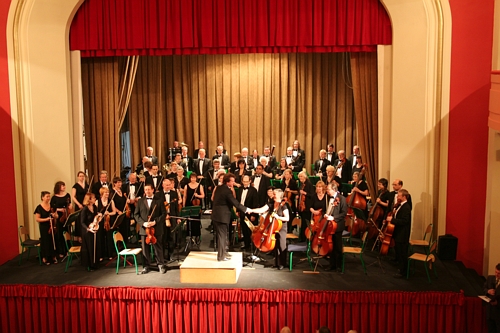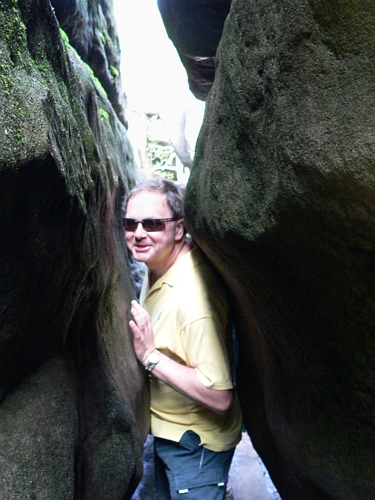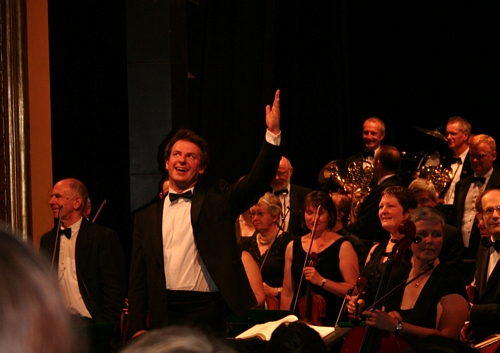Tour 2008: Poland and the Czech Republic
The tour took place in the last week of May with the orchestra split into two groups, one travelling entirely by coach, the other flying to Poland.
The coach party set off early on Saturday morning, while my group flew from East Midlands Airport at a much more reasonable hour the following morning. We arrived in Wroclaw early Sunday afternoon and were taken on a brief tour of the city by our guide Agnieszka, who was to remain with us for the rest of the week. The five star hotel was very luxurious, with slippers, bathrobe and a bathroom with a telephone next to the toilet!
The coach party arrived later that afternoon and we were all taken to the Raclawice Panorama, a large circular building whose inner wall is covered with a fantastically detailed painting of a battle between Polish insurgents and the Russian army. This was followed by dinner at the Spiz Restaurant.
The next morning, we were taken on a walking tour of Wroclaw by Agnieszka and a fellow guide, “Waclaw from Wroclaw”, which included the University Museum with the fabulously decorated Leopoldinum Hall. The ancient university is situated on one of the many islands which fragment the broad and majestic river Oder into many channels. The university had a special point of interest for our orchestra. In 1876 the university, then of Bresslau, conferred an honorary doctorate on Johannes Brahms in the Great Hall and he repaid the compliment by dedicating the Academic Festival Overture to the university and students everywhere.
After lunch, we moved on to Kudowa Zdroj, a town close to the Czech border, where we stayed for the next two nights at another excellent hotel in very pleasant surroundings. After settling in, we were taken to a nearby farm for a demonstration of local handcrafts such as bread-making and pottery followed by a barbeque where we got to cook sausages over an open fire ourselves.
Tuesday morning was spent at Bledne Skaly (Wandering Rocks), having enormous fun clambering over and squeezing between tightly packed stones named after the objects that they supposedly resemble: table, ship, box office (?) etc. Definitely not one for the seriously overweight! In the afternoon we rehearsed for the evening’s concert at Kudowa’s Town Theatre, where we performed Sibelius’ Finlandia, Grieg’s First Peer Gynt Suite, Brahms’ Academic Festival Overture & Elgar’s Enigma Variations to a select but appreciative audience who rewarded us with a standing ovation.
After breakfast, the coach party began the long journey home, leaving the rest of the orchestra to spend a free day exploring Prague and its surroundings, including Kutna Hora, Prague Castle, the Cathedral, the Smetena, Dvorak & Mozart Museums and the Czech Music Museum with its impressive collection of old instruments.
We arrived at Prague Airport early in the evening for our flight back home, only to be delayed for a couple of hours by a strike in Italy. Prague Airport is definitely not the most stimulating place to be stuck in. We finally touched down on British soil at nearly one o’clock in the morning.
By contrast, the coach party got home ahead of schedule, having caught an earlier ferry than planned. Jammy devils.
Thanks as usual to Pat, Jenny and everyone else involved in organising the tour for making it so enjoyable with such excellent accommodation, food and sight seeing. If the next tour is only half as good, I can hardly wait.
Jeremy Oakley
Post script from a coach traveller:
In May 2008 LSO set out on a concert tour of Poland and the Czech Republic. Early start essential, 5 30 at Mayflower Church Hall sees the orchestra gathering to load instruments and luggage for the 2 day journey to Wroclaw, pronounced Vrotswav (formerly Bresslau). Their route went via Dover, Calais and on across the flat fields of Belgium via Antwerp, across a small section of Holland and into Germany. Cross the mighty Rhein at Duisburg through the Ruhr region to the half way point Dortmund for a good night’s rest. The second day starts early as there are 500 miles to cover. At Kassel the route turns south through Hessen then east again through Thuringen, the emotional and geographical heartland of a now united Germany. A medieval fortress, the Wartburg, stands high above the motorway at Eisenach. This is deeply significant. Martin Luther spent several months in hiding here after his trial in Worms. The full panoply of church estate was brought against him but he would not recant and the protestant faith was born. He used his time in the Wartburg to translate the bible into everyday German. The Wartburg is the home of the medieval singing contest and is the setting for Richard Wagner’s Tannhauser. Eisenach is also the birthplace of J S Bach, one of Europe’s greatest musicians. Onward past Weimar, cultural capital of the good old Germany. This is the one time home of Goethe, Schiller, Liszt and Wagner. On a hillside above the town, a huge stone monolith is easily visible – a reminder of the “twelve dark years”. It marks the Buchenwald concentration camp where tens of thousands of enemies of the Nazi regime were worked to death or worse. On through Saxony, across the Elbe and past the beautiful state capital of Dresden. Before leaving Germany, a half hour enforced break courtesy of 2 very apologetic customs police. Sorry, driver, documents not quite in order, pay 192 euros to proceed. Across the Neisse and into Silesia, the first province of Poland. Settlements become sparser. The land starts to take on a slightly unkempt look. Only 2 hours left to Wroclaw. Our hotel is the Radisson in the Old Town. It is here that we join forces with the rest of the orchestra who had flown direct from East Midlands Airport. They may have got there earlier than we did but did they have as much fun?
Sam Dobson




